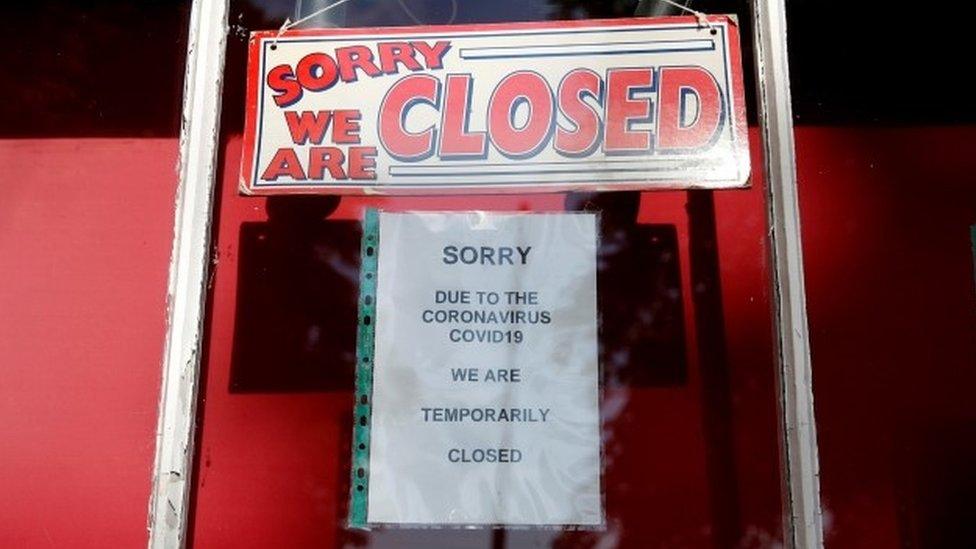Covid: What is a circuit-breaker could one fight the virus?
- Published

Northern Ireland is going to start a two-week circuit-breaker lockdown on Friday 27 November.
It follows the use of a 17-day "firebreak" to try to stem Covid cases in Wales.
What is a circuit-breaker?
A circuit-breaker is a tight set of restrictions designed to reverse the tide of the epidemic and bring the number of cases down.
The rules could feel a lot like the original national lockdown - but crucially a circuit-breaker is for a fixed period of time.
The hope is they are less damaging - to the economy and people's mental health - than a longer lockdown, because people can plan ahead more easily.
How far Covid rates drop would depend on how severe the restrictions were, and how much we stick to them.
The UK as a whole has not yet had a circuit-breaker, with the nations opting to introduce their own measures.
During Wales's circuit-breaker:
People had to stay at home
Pubs, restaurants and non-essential shops were shut
Primary schools and younger years in secondary schools stayed open
Hotels, hairdressers and beauticians all closed
From next Friday in Northern Ireland:
People will have to stay at home
All non-essential shops will close
Pubs and restaurants can offer takeaway services
Schools will remain open
What would a circuit-breaker achieve?
Dr Adam Kucharski, a researcher at the London School of Hygiene and Tropical Medicine, said: "The overarching aim is you don't want intensive care units filling up again, but you also have increased options at lower levels of the virus."
The government's test-and-trace programme is currently only reaching half of infected people's close contacts in some areas, the BBC has learned.
Dr Kucharski said: "As cases and hospitalisations increase, there is less information on what the outbreak is doing, as test and trace can't pick it all up, you don't know where the outbreak is."
The BBC's Laura Foster explains what a circuit breaker is and how it could help tackle Covid-19
How long does a circuit-breaker need to be?
The minimum duration is seen as two weeks.
Anything shorter and the risk is people who are infected just before the start of the circuit-breaker may still be able to spread the virus when it ends.
The longer the circuit-breaker, the more it would reduce cases - but the greater the other impacts on society.
When would we know if a circuit-breaker was working?
Not until after it was lifted.
It can take a week between being infected and developing symptoms, the same again between getting sick and needing hospital treatment, and up to a month before people die.
All of these lags mean the statistics on deaths and hospital admissions are expected to look worse throughout the whole of a circuit-breaker.
It is only later that the benefits begin to trickle through.
What effect did the Wales one have?
Watch how the case rates have changed in the past six weeks across Wales
Wales' 17-day firebreak ended on 9 November.
First Minister Mark Drakeford said the chief medical officer's analysis was the evidence was now "good enough" to show it did "succeed".
He said the number of Covid patients in hospital was "stabilising" and the R number - the number of people someone infects - in Wales the following week "could have been below one".
After Wales' firebreak ended, restaurants, pubs, gyms all reopened and infection rates generally fell the following week in most places.
What happens after a circuit breaker?
Cases will go up again unless something fundamentally changes.
"With a managed short-term lockdown, you buy yourself some time," says Dr Mike Tildesley, from the University of Warwick.
"But you may find yourself in a cycle of short-term lockdowns until you have an exit strategy like a vaccine or herd immunity."
Has it been used anywhere else?
Yes.
The state of South Australia has just entered a six-day lockdown to try to curb an outbreak - its first in six months.
Israel used a circuit-breaker in October after its "traffic-light" system did not get infections under control.
A temporary lockdown in New Zealand, which successfully allowed contact tracers to get back on top of the outbreak there, can be seen as a circuit-breaker even though it was not called that.
Follow James on Twitter, external

LOCKDOWN LOOK-UP: The rules in your area
LOCAL LOCKDOWNS: What happens if you have one?
GLOBAL SPREAD: How many worldwide cases are there?
LOOK-UP TOOL: How many cases in your area?
